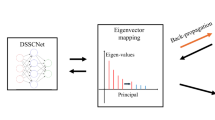Abstract
Sparse representation based face hallucination methods only utilize generic sparsity prior irrespective of the fact that the near bases in dictionary do make a greater contribution to patch reconstruction. Consequently, they cannot provide satisfactory hallucinated results in terms of accuracy and noise robustness. In this paper, instead of modifying the existing ℓ 1 norm regularization, we propose a completely novel trend-constrained regularization method by exploiting a priori known as shape trend regarding coefficient and similarity curves. In particular, this method explicitly encourages the unknown coefficient curve to follow the shape variation trend of a predetermined similarity curve by means of maximizing their correlation. Owning to the differentiability of the underlying model, both the solution and regularization parameter can be analytically tractable, thus avoiding complex numerical optimization. Based on the observation on distance statistics, we further devise two optimal similarity functions in the form of power and exponential kernel functions. The proposed method boosts face hallucination performance considerably compared with the state-of-the-art methods. Experiments on commonly used face database demonstrate its effectiveness.





Similar content being viewed by others
References
Baker, S., & Kanade, T. (2002). Limits on super-resolution and how to break them. IEEE Transactions on Pattern Analysis and Machine Intelligence, 24(9), 1167–1183.
Roweis, S. T., & Saul, L. K. (2000). Nonlinear dimensionality reduction by locally linear embedding. Science, 290(5500), 2323–2326.
Chang, H., Yeung, D. Y., & Xiong, Y. M. (2004). Super-resolution through neighbor embedding. In IEEE Conference on Computer Vision and Pattern Recognition, (pp. 275–282).
Ma, X., Zhang, J., & Qi, C. (2010). Hallucinating face by position-patch. Pattern Recognition, 43(6), 3178–3194.
Candès, E. J., Romberg, J., & Tao, T. (2006). Stable signal recovery from incomplete and inaccurate measurements. Communications on Pure and Applied Mathematics, 59, 1207–1223.
Farsiu, S., Robinson, M. D., & Elad, M. (2006). Fast and robust multiframe super-resolution. IEEE Transactions on Image Processing, 15(1), 141–159.
Zou, H., & Hastie, T. (2005). Regression shrinkage and selection via the elastic net, with applications to microarrays. Journal of the Royal Statistical Society, Series B, 67, 301–320.
Yang, J., Tang, H., Ma, Y., & Huang, T. (2010). Image super-resolution via sparse representation. IEEE Transactions on Image Processing, 19(11), 2861–2873.
Jung, C., Jiao, L., Liu, B., & Gong, M. (2011). Position-patch based face hallucination using convex optimization. IEEE Signal Processing Letter, 18(6), 367–370.
Yu, K., Zhang, T., & Gong, Y. (2009). Nonlinear learning using local coordinate coding. In Proceedings of Advances in Neural Information Processing Systems, (pp. 2223–2231).
Friedlander, M. P., Mansour, H., Saab, R., & Yilmaz, O. (2012). Recovering compressively sampled signals using partial support information. IEEE Transactions on Information Theory, 58(2), 1122–1134.
Jiang, J., Hu, R., Han, Z., Lu, T., & Huang, K. (2012). Position-patch based face hallucination via locality-constrained representation. In IEEE International Conference on Multimedia & Expo, (pp. 212–217).
Zhang, K., Gao, X., Tao, D., & Li, X. (2012). Single image super-resolution with non-local means and steering kernel regression. IEEE Transactions on Image Processing, 21(11), 4544–4556.
Dong, W., Zhang, L., Shi, G., & Li, X. (2013). Nonlocally centralized sparse representation for image restoration. IEEE Transactions on Image Processing, 22(4), 1620–1630.
Xiaoqiang, L., Yuan, Y., & Yan, P. (2014). Alternatively constrained dictionary learning for image super-resolution. IEEE Transactions on Cybernetics, 44(3), 366–377.
Jiang, J., Hu, R., Wang, Z., Xiong, Z., & Han, Z. (2013). Support-driven sparse coding for face hallucination. In IEEE International Symposium on Circuits and Systems, (pp. 2980–2983).
Bose, N. K., Lertrattanapanich, S., & Koo, J. (2001). Advances in super-resolution using L-curve. In IEEE International Symposium on Circuits and Systems, (pp. 433–436).
Nguyen, N., Milanfar, P., & Golub, G. (2001). A computationally efficient super resolution image reconstruction algorithm. IEEE Transactions on Image Processing, 10(3), 573–583.
FEI Face Database (2012), Available at http://fei.edu.br/~cet/facedatabase.html.
Acknowledgments
This work was supported by the National Natural Science Foundation of China (61070080, 61170023, 61172173, 61231015, 61303114, 61172174, 61302111), the Major National Science and Technology Special Projects (2010ZX03004-003-03, 2012YQ16018505, 2013BAH42F03), and the Fundamental Research Funds for the Central Universities (2042014kf0286, 2042014kf0212, 2042014kf0025, 2042014kf0250).
Author information
Authors and Affiliations
Corresponding author
Rights and permissions
About this article
Cite this article
Wang, Z., Han, Z., Wang, Q. et al. Face Hallucination via Trend-Constrained Regularization. J Sign Process Syst 79, 105–111 (2015). https://doi.org/10.1007/s11265-014-0941-9
Received:
Revised:
Accepted:
Published:
Issue Date:
DOI: https://doi.org/10.1007/s11265-014-0941-9




